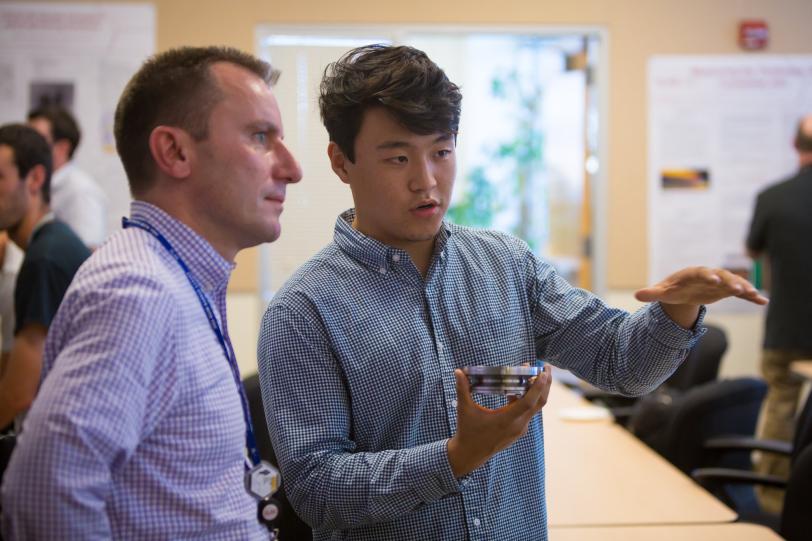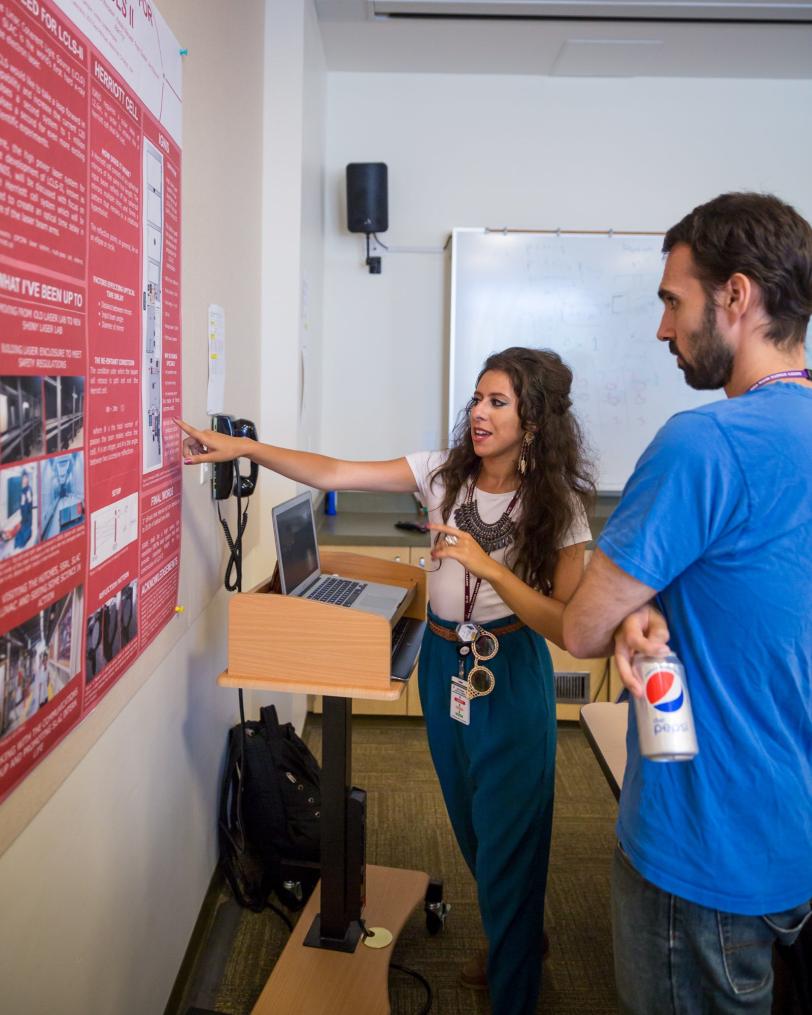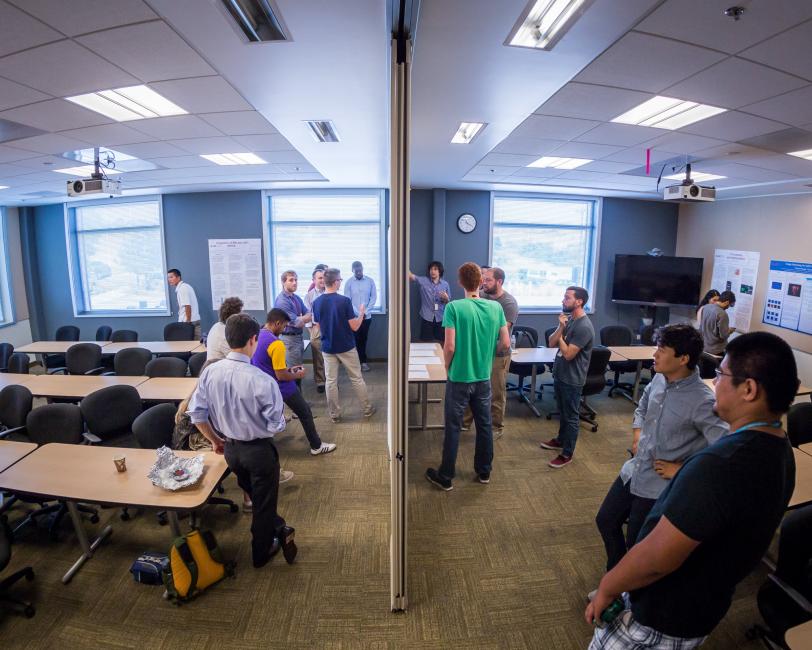College Students Work on Wide Range of Projects at SLAC’s X-ray Laser
More Than 40 Interns Spent 10 Weeks This Summer at the Linac Coherent Light Source
More than 40 college students spent 10 weeks at the Department of Energy’s SLAC National Accelerator Laboratory this summer working on research projects related to the lab’s Linac Coherent Light Source (LCLS) X-ray laser.
The program was started five years ago by Alan Fry, director of the LCLS Laser Science and Technology Division.
“Initially, I recruited interns to work with scientists and engineers in the laser division,” Fry said. “But the program was so successful that we now have interns working with mentors in all areas of the LCLS facility, including X-ray science, engineering, controls and data acquisition, and accelerator operations.”
Fry seeks a wide range of students from all over the U.S., including Stanford students and recent graduates of Eastside College Preparatory School, an East Palo Alto high school that uses a rigorous academic program and extensive mentoring to prepare disadvantaged students to be the first in their families to attend and succeed at four-year colleges. He also encourages interns to return for a second summer, enhancing the benefits to both the student and SLAC.
This year’s 43 interns were selected from hundreds of applicants. Thirty percent were women.
Making biological crystals
Yashas Rao, who had just graduated from California Polytechnic State University, San Luis Obispo, returned for his second LCLS summer as one of six interns working for Hasan DeMirci, a research associate in the Biosciences Division.
Last year, Rao crystallized the large subunit of a ribosome, an essential structure in all living cells that helps translate the genetic code and assemble protein molecules. Rao attempted to grow ribosome crystals in some 3,000 different molecular environments and searched through them all to find the best one.
This summer, Rao was on hand when the LCLS beam focused on that ribosome sample for 47 minutes and generated the information needed to determine the first room-temperature structure for this large subunit.
"This was the largest high-resolution structure solved to date at any X-ray free-electron laser source," DeMirci said. "It was also done in a record short time while using a record-small amount of sample."
Rao was also involved in a project this summer studying recently discovered enzymes, through an international collaboration that included DeMirci, SLAC Biosciences Division Director Soichi Wakatsuki and LCLS instrument scientist Mark Hunter. These enzymes can capture carbon dioxide 100 times faster than the key photosynthetic enzyme RuBisCo, which converts carbon dioxide into sugars in plants. By determining high-resolution atomic structures of one of these alternative enzymes in different stages of the carbon dioxide capture reaction, researchers hope to learn why it is so efficient. Understanding this may lead to insights into alternative energy sources.
To generate and isolate the target enzyme, Rao grew cells from various bacteria samples, expressed the key genes, isolated the enzyme from each, crystallized them and determined the structure of the most suitable sample.
“From the data we have, we are already seeing initial clues of how this enzyme binds to the other molecules involved in the reaction,” Rao said. “Our next step is to determine the structures of the enzymatic reaction intermediates and make a molecular movie that shows in detail how this enzyme captures carbon dioxide.”
His two LCLS internships have had a tremendous impact on Rao’s research skills.
“They have helped me become a more mature scientist,” Rao said. “I have learned so much from Hasan, who is meticulous. I now have confidence in being able to carry a project from start to finish.”
Big Data Challenges
A rising sophomore engineering major at Harvey Mudd College, Marisol Guzman is just starting her journey in science, and she faced a steep learning curve early this summer.
Her project for Ryan Coffee, LCLS staff scientist, involved using the Python computer language to plot and analyze data from an LCLS experiment.
“At first I didn’t know what he was talking about,” she said. “But I soon realized that it’s fine not to know all the answers and to ask questions.”
Software engineer David Schneider was especially helpful in expanding her knowledge of Python and showing her how to plot and slice the data.
Guzman said her work this summer with a large volume of LCLS data should give her an advantage in the datasets class she will be taking at Harvey Mudd this year.
‘A Bit Non-traditional’
Meriame Berboucha learned about SLAC when LCLS Director Mike Dunne gave a seminar at his alma mater, Imperial College in London, England, where she is a physics student with a strong interest in lasers.
She applied for a scholarship that Imperial gives three women for summer research overseas, and proposed SLAC as her destination.
“She didn’t get it, but her application so impressed us that we offered her one of our internships, if she could pay her own travel to and from Palo Alto, since we didn’t have funds for that,” Fry said. “It was a bit non-traditional.”
Berboucha’s parents agreed, and the London native was off on her first-ever trip away from home.
Her project was to help design and build a time-delay cell for an optical laser system that will simulate the high power and repetition rate of the next-generation LCLS. The system will be used to test diagnostic equipment and data retrieval techniques for the new free-electron X-ray laser that is currently under construction.
“I liked learning something new and having my own system to work with,” Berboucha said. "There were so many parameters I could change, including input angles and distances between the cell's mirrors, to adjust the time delay."
Berboucha is also an enthusiastic promoter of science, especially to women. She created a science club at her middle school and a Women in Physics society at Imperial. She was a finalist in the United Kingdom’s Institute of Physics “Early Communicator” competition and is an active blogger and Twitter user.
Berboucha has returned to London for her fourth year at Imperial, which will earn her a masters’ degree. She plans to pursue a PhD, but hasn’t decided whether to do that in the U.K. or the U.S.
“Being at SLAC this summer opened my eyes to a wider realm of science and has made me even more enthusiastic about it as a career,” she said. “I’m currently torn between ambitions in academia – I love to teach – and being the next Brian Cox,” a particle physicist who is also a popular BBC-TV host and science explainer.
“I’m a scientist who communicates,” she said. “But the science part came first.”
LCLS is a DOE Office of Science User Facility.
For questions or comments, contact the SLAC Office of Communications at communications@slac.stanford.edu.
SLAC is a multi-program laboratory exploring frontier questions in photon science, astrophysics, particle physics and accelerator research. Located in Menlo Park, Calif., SLAC is operated by Stanford University for the U.S. Department of Energy's Office of Science.
SLAC National Accelerator Laboratory is supported by the Office of Science of the U.S. Department of Energy. The Office of Science is the single largest supporter of basic research in the physical sciences in the United States, and is working to address some of the most pressing challenges of our time. For more information, please visit science.energy.gov.








